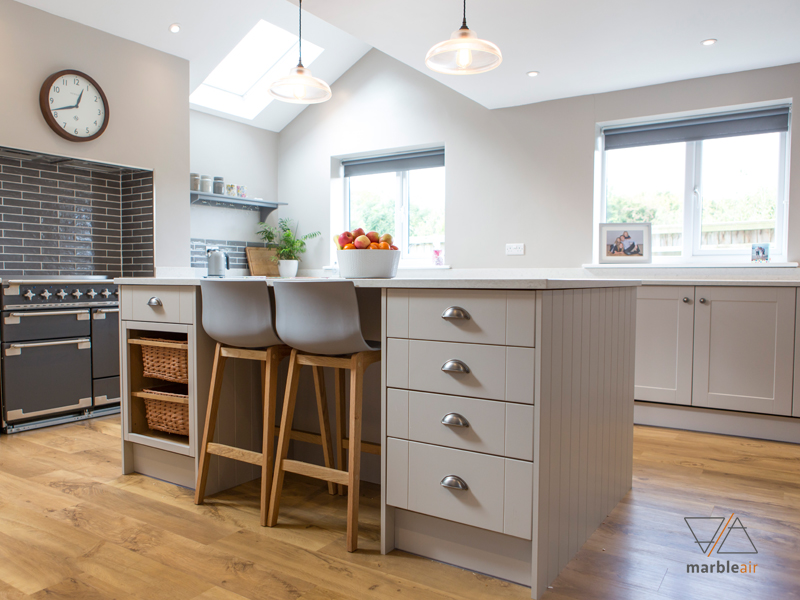
Alternative, Eco-Friendly Construction Within Budget
The focus on going ‘green’ and applying eco-friendly consideration in construction is a noble, global trend. The World Green Building Council is committed to reaching net-zero energy targets for all new buildings by 2030 and for ALL buildings by 2050.
A Zero-energy building (ZE), also known as a zero net energy (ZNE) building, net-zero energy building (NZEB), is a building with zero net energy consumption. This means that the total amount of energy used by the building on an annual basis is equal to the amount of renewable energy created on the site.
In layman’s terms, a zero-energy status is given primarily due to achieving an air-tight, eco-friendly, thermal building. This means a building which doesn’t lose energy via windows, walls, roofs, doors, chimneys and even through its foundations.
In the UK, all new homes should have conformed to standards set by the PassivHaus system by 2013, and to have reached ‘zero carbon’ by 2016! Ok so maybe we’re a tad behind but aiming high is not a mistake. More and more UK citizens are understanding the value of eco-friendly home extensions, eco-friendly solutions for refurbishments and existing homes as well as new builds.
Let’s examine how many eco-friendly measures we can apply to our planned construction and join the worldwide journey to zero-energy.

Extensions & New Constructions Start the Eco-Friendly Ball Rolling
It’s often the unfamiliar that holds us back from advancement. There is no better way to acquaint ourselves with eco-friendly ideas than doing so for our home extension or construction plans.
The first step is to bring an eco-savvy architect on board.
The considerations range from building materials to management of light, heat, and water. The rule is; when you increase the amount of natural light in the building and lower its heat loss and water consumption, the energy bill will reduce.
It follows then, that it’s worthwhile using eco-friendly materials and sustainable products. Think of the money we’ll be saving year after year having built an extension that is longer-lasting than traditional ones.
Top Eco-friendly Construction
It is little known that commercial concrete materials release tonnes of greenhouse gas carbon dioxide (CO2) into our atmosphere each year, which contributes to our planet’s climate change calamity. Here are some alternatives, which offer a lower environmental impact. We trust it will inspire you to push the boundaries and build with more foresight towards the generations to come.
- Hay Bales – If it’s the last straw, we do well to understand the eco-friendly construction techniques being used successfully all over the world in the use of hay or straw. The bonus is that properly sealed hay bales provide excellent levels of insulation whether the climate is hot or cold!
- Rammed Earth – used by civilization for centuries, compressed earth can be made safer using rebar or bamboo. Today’s technology leaves rammed earth with a similar feel to concrete.
- Bamboo – known as the quintessential rapidly renewable building material with a compressive strength of concrete and the tensile strength of steel.
- Mycelium – an ultimate eco-friendly material but what is it? Well, ‘what’s the only room with no walls?’ A mushroom! Architect David Benjamin is flipping the script on that old joke with some incredible mycotecture (mushroom architecture) built from mushroom bricks!’ reports Inhabitat.
- Wood – Inhabitat reminds us that ‘not only do trees absorb CO2 as they grow, but they also require much less energy-intensive methods to process into construction products. Properly managed forests are also renewable and can ensure a biodiverse habitat’. This keeps wood a strong contender for eco-friendly construction.
- HempCrete – an ingenious eco-friendly idea, developed by ‘U.K.-based Lhoist Group, Tradical® Hemcrete®, 7 x stronger than concrete, is a bio-composite, thermal walling material made from hemp, lime and water. What makes it carbon negative? There is more CO2 locked-up in the process of growing and harvesting of the hemp than is released in the production of the lime binder.’
- AshCrete – is a concrete alternative that uses fly ash instead of traditional cement. By using fly ash, a by-product of burning coal, 97 percent of traditional components in concrete can be replaced with recycled material.
- Timbercrete – though made of sawdust and concrete mixed together, is eco-friendly because the sawdust both reuses a waste product and replaces some of the energy-intensive components of traditional concrete.
- Recycled Plastic – creating a type of concrete that includes ground-up recycled plastics and trash, not only reduces greenhouse gas emissions but also reduces weight and provides a new use for landfill-clogging plastic waste.
- Ferrock – this unique material absorbs and traps carbon dioxide as part of its drying and hardening process – making it not only less CO2 intensive than traditional concrete but actually carbon neutral. Ferrock consists of recycled materials including steel dust from the steel industry.
Zero Energy Building to Infinity & Beyond
In light of all the foregoing, the new golden standard for construction is zero energy building. To qualify for this rating, a building or home must be “so air-tight, well insulated, and energy-efficient that they produce as much renewable energy as they consume over the course of a year, leaving the occupants with a net-zero energy bill, and a carbon-free home.” to quote Zero Energy Project.
“A zero-energy home is not just a ‘green home’, or a home with solar panels. A Zero energy home combines advanced design and superior building systems with energy efficiency and on-site solar panels to produce a better home. Zero energy homes are ultra-comfortable, healthy, quiet, sustainable homes that are affordable to live in.”
The problem is that passive, energy-efficient homes awarded zero-energy rating status have sometimes been built from artificial man-made materials designed for optimum performance. The production of these materials and systems still contributes to the release of greenhouse gasses into the atmosphere. This is counterintuitive and certainly not healthy for the planet.
Therefore, the type of material used in building construction is vital in contributing to the level of eco-friendliness and the sustainability of their long-term performance.
For those who are environmentally aware and eager to change the global status quo, eco-friendly construction methods are the way forward. If this is your route, please feel free to contact Anna and her exceptional team at MarbleAir who will be able to assist you with your next ‘green project’.
Watch this space as we explore zero energy buildings in future articles.
